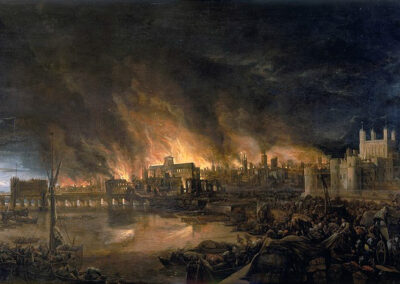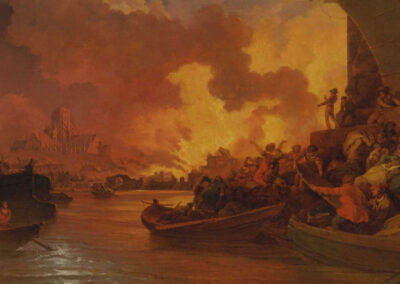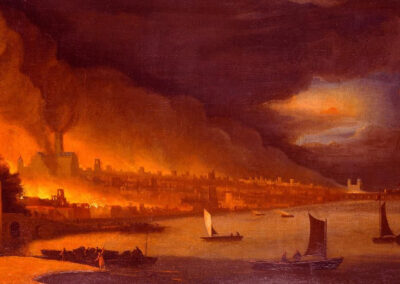
Great Fire of London
Sir Thomas goes back to bedFire!
Shortly after midnight on Sunday 2 September 1665, a fire broke out in the bakery of Thomas Farriner of Pudding Lane, central London. In no time, 300 houses were ablaze and a strong east wind continued to jump the fire from house to house through the winding, closely packed warrens of streets that was 1600s London.
Sir Thomas Bloodworth, the Lord Mayor of London, was early on notified of the fire. Had he ordered the city militia and watchmen to begin making firebreaks, the outcome might have been different. He concluded the situation was inconsequential and retired back to bed.
When it finally became clear that the mayor was incapable of acting, the city council took action without him. Standard procedure was employed. Men were dispatched to create firebreaks by pulling down streets of houses with long hooked poles well in advance of the fire. However, stopping the fire was, by then, impossible. It was a conflagration of immense proportion moving at a speed never before experienced.
Orders were given to abandon the fire fight and instead, save irreplaceable plate from the churches and guildhalls, artwork and relics.Samuel Pepys quickly reported the situation to King Charles II. The King promptly ordered large-scale demolitions but it was all to no avail. The fire pushed north on Monday into the heart of the city. The King himself manned a bucket brigade. The authorities resorted to gunpowder to create firebreaks. Rumours spread that foreigners were responsible and that the explosions heard were the French invading the city. Panic ensued and many French and Dutch were lynched and assaulted. Refugees poured out of the city, hampered by thousands of people who had come into London to witness the event. Saint Paul’s Cathedral could not escape. As fire engulfed it’s huge roof, acres of lead sheathing melted and poured down onto the streets below.
By Tuesday, the fire had spread across the entire medieval City of London inside the Roman wall. By September fire, the fire had been contained and on September 6, it was extinguished. Only one-fifth of London was left standing. Destroyed were 13,200 houses, 87 parish churches, St Paul’s Cathedral and most of the city’s administrative buildings. Seventy to eighty thousand inhabitants were left homeless. The social and economic challenges which followed were enormous. The death toll, officially reported as minor, has been debated by historians, some arguing that many of the poor who died were unaccounted for.
From Pepys Diary
Sunday 2 September 1666
“I was called for, and did tell the King and Duke of Yorke what I saw, and that unless his Majesty did command houses to be pulled down nothing could stop the fire. They seemed much troubled, and the King commanded me to go to my Lord Mayor and command him to spare no houses, but to pull down before the fire every way.
At last met my Lord Mayor in Canningstreet, like a man spent, with a handkercher about his neck. To the King’s message he cried, like a fainting woman, “Lord! what can I do? I am spent: people will not obey me. I have been pulling down houses; but the fire overtakes us faster than we can do it.” That he needed no more soldiers; and that, for himself, he must go and refresh himself, having been up all night. So he left me, and I him, and walked home.
[ I ] walked to my boat; and there upon the water again, and to the fire up and down, it still encreasing, and the wind great. So near the fire as we could for smoke; and all over the Thames, with one’s face in the wind, you were almost burned with a shower of firedrops. This is very true; so as houses were burned by these drops and flakes of fire, three or four, nay, five or six houses, one from another.
[We] staid till it was dark almost, and saw the fire grow; and, as it grew darker, appeared more and more, and in corners and upon steeples, and between churches and houses, as far as we could see up the hill of the City, in a most horrid malicious bloody flame, not like the fine flame of an ordinary fire.”
A Tribute To Samuel Pepys
Samuel’s womanizing would hardly ’cut the mustard’ today. Yet despite that, he did care deeply for his wife, always ensuring her well-being. Although his claim to fame today is his diary and the light it has shed on the period it referenced, 1660-1669, there was much more to Samuel’s accomplishments. He was a hard-working, highly competent naval administrator who brought much-needed modernizations to the British Navy at a critical time. What made Samuel so effective at his job was his capacity as a connector and influencer of people and ideas.
The glue which made those attributes so effective was his nature. He was straight forward yet tactful, intellectual, politically astute, an incomparable conversationalist, affable, fun-loving and caring. Samuel had the ear, it seems, of every important person in his day, including the king, the Duke of York and the aforementioned Hans Sloane. His friends and associates stretched from intellectuals, politicians, merchants and government officials to humble servants and pedlars. He was truly a man of the people who earned the love and admiration of all those he touched.
Sir Thomas Bloodworth (1620-1682)
Thomas Bloodworth was born in London where he lived for his entire life. At 15, he was apprenticed to a vintner and and later became a member of the Vintners Guild. Years on, he became a so-called Turkey merchant — a member of the Levant Company which held an English charter to do business in the Levant or middle east including Turkey. Bloodworth’s primary interest was trading in timber.
Bloodworth was a man with many ‘irons in the fire.’ He was a member of the Committee of the East India Company (EIC) from 1661-1665 and thus, would have had regular dealings with Samuel Pepys, who worked closely with the EIC on British Navy matters. As well, Bloodworth was a member of the Court of Assistants (Board of Directors) of the Levant Company, was a London alderman, an avid royalist MP, one of two London sheriffs, and Master of the Vintners Company. Notably, Bloodworth was also a director of the Royal Africa Company, which held the British monopoly on slave trading out of West Africa and supplied all slaves to the Caribbean and British North America.
In 1660 he was knighted by King Charles II for aiding the King’s return from exile and over the period of 1660-1682 Bloodworth was Colonel of the Orange and Yellow London Regiments. In November of 1665, nine months before the Great Fire, Bloodworth was elected Lord Mayor of London. In short, Thomas Bloodworth was a well-connected man. How capable he was is a matter for debate.
When Pepys found Bloodworth at the scene of the fire, Bloodworth refused to allow demolition to proceed. Perhaps he was feeling pressured by owners of the houses and city aldermen, but outwardly, he downplayed the seriousness of the fire, saying “a woman might piss it out”, then returned to his home and bed. Pepys diary comments make it abundantly clear that he held a great distaste for the man. “he cried, like a fainting woman, ‘Lord! what can I do?’”
Bloodworth’s handling of the London Fire fell far short of heroic and might be more accurately described as anemic. Samuel Pepys would have agreed with that. In his diary, Pepys describes Bloodworth as “a silly man I think” and “a very weak man he seems to be” as well “a zealous person in the King’s concernments; willing though it may be not very able, to do great things.” (30 June 1666)
In partial defence of Bloodworth’s inaction, there was a critical procedural flaw that played a significant role in the outcome —authority to demolish houses came from the King. If the Lord Mayor of London went ahead and ordered demolition without the King’s authority, he risked being liable for the cost of reconstructing the demolished houses later, a cost so substantial that it almost certainly would have rendered Bloodworth penniless. That thought must have crossed his mind more than once and may well have contributed to his inaction.
The counter-argument, of course, is that a capable leader would have assessed the risk to the community, put aside self-interest and acted swiftly to contain the fire. My personal view: Thomas Bloodworth said the right things to the right people to advance his own interests, in the absence of any inclination or ability to turn words into meaningful action. Thomas Bloodworth was an opportunist.
Origins
Sir Thomas Bloodworth, Lord Mayor of London, was born in London in 1624. His family originated from Derby, then a small village in the English Midlands. You don’t suppose, I mused…. Yes, indeed, my 11th great grandfather, George Bloodworth (1560-1630), was Sir Thomas’s grandfather. Little Sir Thomas might have gathered for Christmas at Grandpa George’s house. Grandpa might have got a roaring bonfire going behind the house and say to Thomas, “ Come sit on my knee, Thomas, and warm yourself by the fire. Now isn’t that nice?: “Yes Grandpa, it sure is.”
Sir Thomas is my 1st cousin, 11x removed.



